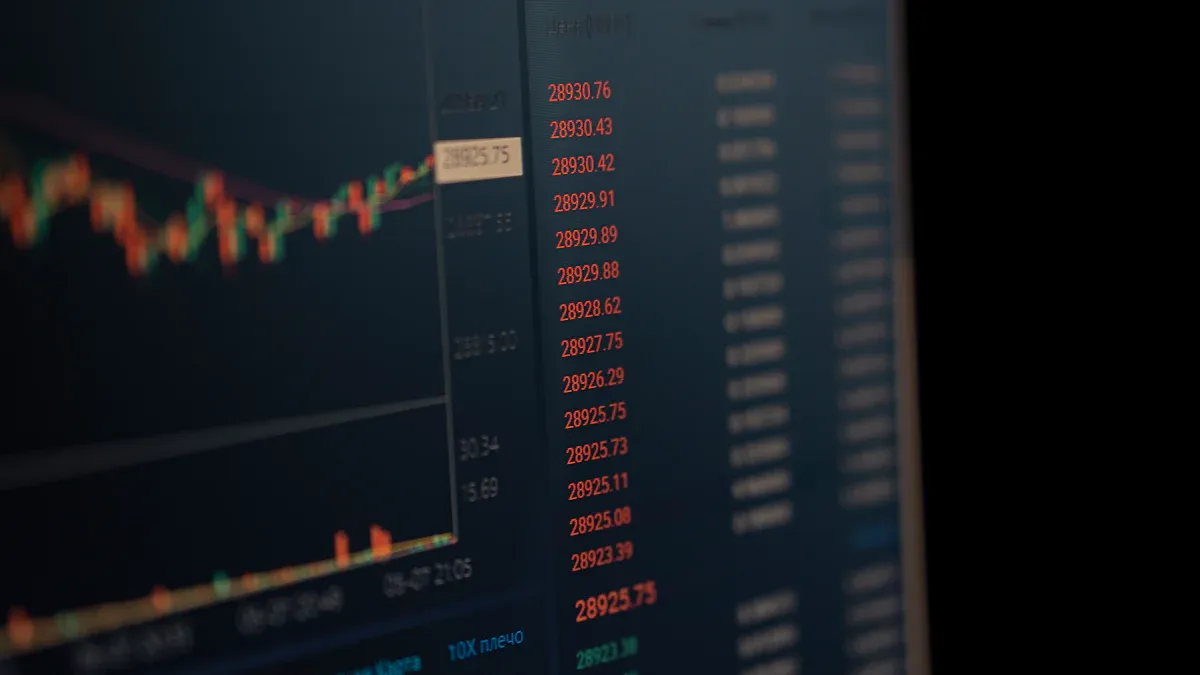- EasyCard
- Trade
- Help
- Announcement
- Academy
- SWIFT Code
- Iban Number
- Referral
- Customer Service
- Blog
- Creator
Are you still watching when it falls? Try short selling strategy

Image Source: pexels
Are you watching during a market downturn, worried about missing opportunities? Data shows that 43% of investors choose to hold cash and observe during market declines, while only 33% remain bullish, as shown in the table below:
| Investor Sentiment | Percentage |
|---|---|
| Bearish | 43% |
| Bullish | 33% |
Some investors opt for short selling strategies. Over the past decade, the short interest in the S&P 500 has ranged between 1.6% and 2.9%, dropping to about 1.6% in 2020 due to COVID-19. Short sellers trade overvalued stocks during market downturns, helping the market discover true prices more quickly. By understanding short selling strategies, you can actively respond to market fluctuations.
Key Points
- During market downturns, short selling strategies can help you actively profit instead of passively watching. Understanding the basic process and risks of short selling is crucial.
- Short selling is suitable for experienced investors. You need market analysis skills and risk management techniques to handle potential unlimited losses.
- Using stop-loss orders and hedging strategies can effectively reduce risks in short selling. Allocate funds reasonably to avoid significant losses due to market fluctuations.
- Choose the right market environment and timing for short selling. Technical analysis and market momentum indicators can help you determine if short selling is appropriate.
- Continuously learn short selling knowledge and improve risk management skills. Understand market rules and operational precautions to ensure legal and compliant investment behavior.
Watching or Acting During a Downturn

Image Source: unsplash
Common Investor Choices
You may hesitate during a market downturn. Many investors choose to withdraw funds or pause trading, known as “watching during a downturn.” This approach is common, especially during significant market volatility. You can refer to the following common behaviors:
- Many investors watch due to fear, avoiding further losses.
- Some completely exit the market, waiting for stability before re-entering.
- Some stick to long-term investment plans, staying calm and unaffected by short-term fluctuations.
- Some adopt dollar-cost averaging strategies, spreading risk and reducing pressure from single investments.
You may notice that while watching during a downturn can reduce short-term losses, historical data shows markets typically rebound after declines. If you choose to watch, you may miss gains from market recoveries. Staying calm and developing a suitable investment plan can help you minimize emotional impacts during volatility.
Investment decisions are often influenced by emotional factors, such as fear and greed. External information and advice from friends may also make you hesitant. You need to learn to distinguish which information is truly helpful for your investments.
Watching vs. Short Selling Comparison
When you watch during a downturn, you’re essentially waiting for the market to recover. However, you can also act proactively by trying short selling strategies. The table below helps you compare the characteristics of these two approaches:
| Strategy | Key Features | Suitable For | Potential Risks |
|---|---|---|---|
| Watching During Downturn | Maintains capital safety, waits for market rebound | Conservative investors | Misses rebound gains |
| Short Selling | Profits from price declines or hedges risks | Experienced investors | Potentially unlimited losses |
You can consider your risk tolerance and investment goals when choosing. Watching suits investors unwilling to take additional risks. Short selling is suitable for those looking to profit actively or hedge risks during downturns. In the U.S. market, institutional investors often use short selling strategies to profit from price declines or hedge long-term holdings. If you have the relevant knowledge and experience, you can try short selling, but you must pay attention to risk management.
- Short selling requires you to borrow and sell stocks, waiting for prices to fall before buying back to return them. The process is more complex than watching.
- During market volatility, short selling strategies can help mitigate losses, but if misjudged, losses can be significant.
- Watching is simple but may cause you to miss market rebound opportunities.
When you watch during a downturn, you’re prone to emotional influences, such as fear leading to premature market exits. Short selling requires stronger psychological resilience and risk control skills. You can choose the strategy best suited to your investment experience and market judgment.
Short Selling Principles
Basics of Short Selling
When learning short selling, you first need to understand its basic process. Short selling is an investment method that allows you to profit during market downturns. You don’t need to own the stock to short sell. You need to borrow stocks from a broker and sell them in the market. When the stock price falls, you buy back the same number of shares to return to the broker. This way, you can profit from the price difference.
When holding a short position, you need to bear financing and borrowing costs. Brokers charge certain fees, which affect your final returns. You also need to note that short selling carries high risks. If the stock price rises, your losses could be unlimited. In the U.S. market, short selling is legal, but regulators impose strict restrictions on naked short selling (selling without borrowing stocks). Naked short selling may lead to market manipulation and greater risks.
Short selling is not only an investment tool but also an important mechanism for market price discovery. You can help the market reflect a company’s true value faster through short selling, but you must ensure compliant operations to avoid violations.
You can refer to the following basic mechanisms of short selling:
- Short selling is the act of selling stocks you don’t own.
- When short selling, you must borrow stocks to ensure smooth settlement.
- When holding a short position, you need to bear ongoing financing and borrowing costs.
The U.S. market has clear regulations for short selling. You must borrow stocks first and cannot sell non-existent shares directly. Naked short selling is illegal and may lead to market manipulation. Regulators strictly review manipulative trading to prevent predatory short selling and misleading statements. Financial institutions and brokers bear significant responsibility in preventing illegal short selling.
Short Selling vs. Buying
When choosing investment strategies, you often compare short selling with traditional buying. The risk and profit sources of the two are completely different. You can refer to the table below for key differences:
| Feature | Short Selling | Traditional Buying |
|---|---|---|
| Potential Loss | Unlimited loss | Limited loss |
| Profit Source | Profits from market declines | Profits from market rises |
| Risk Management | Can be used as a hedging tool | Mainly relies on market rises |
When you short sell, profits come from stock price declines. When you buy, profits come from stock price rises. The biggest risk in short selling is that stock prices can rise indefinitely, leading to significant losses. The maximum risk in buying is the stock price falling to zero, with limited losses. You can use short selling as a hedging tool to reduce overall portfolio risk. In the U.S. market, institutional investors often use short selling to hedge long-term holdings, mitigating the impact of market fluctuations.
You also need to be aware of legal and ethical risks. U.S. regulators strictly monitor manipulative short selling. Predatory short selling can severely impact small companies, and regulators will intervene with investigations. Naked short selling is illegal, and financial institutions and brokers are responsible for preventing such transactions. You must comply with market rules during operations to ensure legal and compliant investment behavior.
Short selling and buying each have advantages and disadvantages. You can choose the strategy best suited to your risk tolerance and market judgment. Understanding the differences helps you make wiser decisions during market fluctuations.
Short Selling Process
Short Selling Steps
When short selling in the U.S. market, you can follow these steps:
- Select Target Stocks: You need to research the market and identify stocks you believe will decline in the future.
- Place a Sell Order: You place a sell order through a brokerage platform. The system automatically borrows stocks you don’t hold, showing as a negative position in your account.
- Wait for Price Decline: You hold the short position, monitor market trends, and wait for the stock price to drop to your target level.
- Buy Back Stocks to Cover: When you believe the timing is right, you buy back the same number of shares to close the negative position. The difference between the sell and buy prices is your profit or loss.
You need to pay attention to transaction costs during the process. Although short selling costs are relatively low, they still affect your final profitability. Some markets impose restrictions on short selling, which may reduce the strategy’s effectiveness.
The short selling process is straightforward, but each step requires careful judgment of market trends and risks. You can practice on a simulated trading platform to improve operational proficiency.
Common Tools
You can choose various platforms and tools for short selling in the U.S. market. The table below shows several common platforms and their features:
| Platform | Features | Suitable Investor Type |
|---|---|---|
| TradeStation | Comprehensive technical trading tools, suitable for active traders | Active traders |
| eToro | Supports CFD short selling, strong social features, suitable for beginners | Beginners and social investors |
| TradeZero | Transparent fees, good positioning services, suitable for beginners | Beginners to intermediate traders |
| Interactive Brokers | Low fees, multiple tools, suitable for advanced traders | Advanced traders |
| CenterPoint | Access to many borrowable stocks, fast order processing, suitable for intermediate to advanced traders | Intermediate to advanced traders |
| Webull | User-friendly interface, commission-free short selling, suitable for modern investors | Modern investors |
| Charles Schwab | Rich research tools, low fees, suitable for all investors | All types of investors |
When choosing a platform, you can select based on your trading experience and needs. Different platforms’ fee structures and tool support affect your short selling strategy’s effectiveness. You can prioritize platforms with comprehensive features and reasonable fees to enhance trading efficiency and profitability.
Short Selling Risks

Image Source: pexels
Profits and Risks
Choosing to short sell during a market downturn indeed offers profit opportunities. However, you must understand that short selling itself is extremely risky. Here are the main risks you may encounter:
- Potential for unlimited losses: If the stock price you borrowed rises, losses can be unlimited.
- Market trend impact: The U.S. stock market generally shows a long-term upward trend, which is unfavorable for short sellers.
- Short squeeze risk: When a stock suddenly surges significantly, many short sellers rush to buy back to cover, driving the stock price even higher.
- Margin trading risks: If the shorted stock rises sharply, your broker may require additional margin, or they may force a cover.
- Global economic event impacts: During the COVID-19 pandemic, many short sellers targeted companies with poor liquidity, especially in countries with limited fiscal capacity. During market turmoil, short sellers typically focus on companies with lower credit ratings, which may yield significant profits but also increase risks.
When operating in the U.S. market, you also need to note regulatory restrictions. The table below shows key regulatory measures:
| Regulatory Restriction Type | Description |
|---|---|
| Uptick Rule | Short selling is only allowed when the stock price is rising, preventing excessive selling pressure. |
| Regulation SHO | Brokers must confirm stocks are borrowable to prevent naked short selling. |
| SEC Reporting Requirements | Institutional investors must report short positions monthly to enhance market transparency. |
Stop-Loss and Risk Management
To control risks in short selling, you must learn to use stop-loss and diversified investment tools. The following methods can help you reduce losses:
- Use stop-loss orders: When a company releases bad news, stop-loss orders can protect you, avoiding long-term losses. Stop-loss orders can automatically close positions when prices are unfavorable, reducing risk. However, during significant market volatility, stop-loss orders may experience price slippage, resulting in actual transaction prices deviating from expectations.
- Hedging strategies: You can offset downside risks through hedging strategies. Even if short-term profits are not made, hedging can limit loss periods and improve overall investment returns.
- Diversified investments: You can spread investments across different assets to balance risks during market fluctuations.
Short selling is a high-risk operation. You must strictly set stop-losses, allocate funds reasonably, and avoid significant losses due to sharp market fluctuations. You also need to monitor regulatory changes in the U.S. market and adjust strategies promptly to protect your capital safety.
Short Selling Tips
Market Environment Selection
When considering short selling strategies, you first need to focus on the market environment. In the U.S. market, technical analysis and market momentum indicators can help you determine if short selling is suitable. The table below summarizes common favorable conditions:
| Market Condition | Description |
|---|---|
| Technical Analysis | You can use technical analysis tools to identify downtrends and market momentum. |
| Bearish Strength Indicator | When this indicator remains negative, it signals strong bearish momentum, suitable for short-term short selling. |
| Average True Range (ATR) | High ATR values indicate significant market volatility, helping you set stop-losses and understand price fluctuations. |
| Event-Driven | Earnings releases, regulatory changes, or other events may lead to rapid stock price declines. |
| Overall Market Decline | Beginners are better suited to try short selling during overall market downturns, as risks are relatively lower. |
You can also focus on specific events, such as failed acquisitions, earnings misses, or poor market reactions to new products, which may trigger rapid stock price declines. High-liquidity markets help you complete large transactions smoothly, reducing risks from price fluctuations. Low liquidity may lead to wider bid-ask spreads, increasing operational difficulty.
Investor Types
You need to choose whether to participate in short selling based on your experience and risk tolerance. Watching during a downturn suits investors with lower risk tolerance. If you have market analysis skills and can proficiently use technical indicators and risk management tools, you can try short selling strategies. Professional traders often use tools like RSI and MACD to find optimal entry points and strictly control positions and stop-losses. Beginners are advised to try short selling during overall market downturns, avoiding operations in high-volatility or low-liquidity environments.
| Research Topic | Impact |
|---|---|
| Individual Investors’ Short Selling Ability | Allowing individual investors to short sell certain stocks helps with market price discovery. |
| Market Efficiency | Individual investor participation in short selling can enhance market efficiency. |
| Stock Volatility | Stock return volatility changes little after short selling is allowed. |
| Bid-Ask Spread | After short selling is allowed, bid-ask spreads narrow, making trading smoother. |
Operational Precautions
When executing short selling, you must comply with relevant rules and avoid common mistakes. The table below lists key operational regulations in the U.S. market:
| Rule | Description |
|---|---|
| Rule 204(a) | Failure to deliver securities on time requires buying or borrowing related securities within the specified period to close the trade. |
| Rule 204(b) | If a trade isn’t closed on time, clearing brokers must not accept new short sale orders unless sufficient stocks are borrowed. |
| Rule 204© | Clearing brokers must notify relevant brokers of the start and end times of short sale restrictions. |
You also need to note the following:
- When a company pays dividends or other distributions, short position holders are responsible for corresponding obligations.
- If a stock is delisted or trading is halted, you may not be able to cover positions in time, increasing risks.
- In some cases, brokers may automatically close positions, leaving you unable to control losses.
- Common beginner mistakes include not understanding short selling risks, overconfidence, ignoring market trends, and failing to set stop-loss points. You should avoid these issues, always set stop-losses, and control positions reasonably.
Short selling is a high-risk operation. You should continuously learn related knowledge, utilize educational resources suitable for beginners and advanced investors, and improve risk management skills. You can choose to read concise articles, in-depth analysis reports, or take systematic courses to gradually build your investment system.
When you watch during a downturn, you may miss opportunities to actively address market declines. Short selling strategies can help you enhance price efficiency during crises, especially when companies have low financial flexibility. Long-term hedging strategies, such as defined risk strategies, can offer greater flexibility and loss mitigation in bear markets. You should rationally choose whether to adopt short selling strategies based on your situation and continuously improve risk management skills.
| Short Selling Strategy Value | Risk Warning |
|---|---|
| Enhances efficiency during crises | Losses may amplify |
| Long-term hedging offers more flexibility | Requires strict risk management |
FAQ
How much capital is needed for short selling?
You can short sell with relatively little capital, but brokers typically require a certain margin. In the U.S. market, you generally need at least 50% of the account’s total value as margin.
Does short selling affect credit records?
Short selling in the U.S. market does not directly affect your credit record. As long as you meet margin requirements and comply with rules, your credit won’t be impacted.
How is profit calculated in short selling?
After selling borrowed stocks, you wait for the price to fall and buy back. The sell price minus the buy price, after deducting fees, is your profit.
What happens if short selling fails?
If the stock price rises, you need to buy back at a higher price. Your losses have no upper limit. Brokers may force a cover to prevent excessive losses.
Is short selling different from leveraged investing?
In short selling, you borrow stocks, while in leveraged investing, you borrow money to buy stocks. Both amplify returns and risks, but the methods differ.
Short selling is a powerful tool to generate profits or hedge against market downturns, but its inherent high risk demands a platform that provides superior speed and minimal friction. Traditional cross-border funding and high commissions can severely undermine the tight margins and quick execution required for a successful short-selling strategy.
This is where BiyaPay becomes essential. We offer zero commission for contract limit orders, a critical advantage for professional traders who need low-cost entry and exit points. Furthermore, our ability to swiftly convert between fiat and digital currencies (like USDT) means your capital can be moved and deposited rapidly to meet margin calls or capitalize on fast-moving market shifts.
You can register quickly—in just 3 minutes without requiring an overseas bank account—to gain integrated access to US and Hong Kong Stocks for your shorting and hedging needs. Utilize our real-time exchange rate checks to manage foreign exchange risk and benefit from international remittances with fees as low as 0.5%, saving you up to 90% in costs. Start trading with the efficiency and low cost that sophisticated strategies demand.
*This article is provided for general information purposes and does not constitute legal, tax or other professional advice from BiyaPay or its subsidiaries and its affiliates, and it is not intended as a substitute for obtaining advice from a financial advisor or any other professional.
We make no representations, warranties or warranties, express or implied, as to the accuracy, completeness or timeliness of the contents of this publication.




Contact Us
Company and Team
BiyaPay Products
Customer Services
is a broker-dealer registered with the U.S. Securities and Exchange Commission (SEC) (No.: 802-127417), member of the Financial Industry Regulatory Authority (FINRA) (CRD: 325027), member of the Securities Investor Protection Corporation (SIPC), and regulated by FINRA and SEC.
registered with the US Financial Crimes Enforcement Network (FinCEN), as a Money Services Business (MSB), registration number: 31000218637349, and regulated by FinCEN.
registered as Financial Service Provider (FSP number: FSP1007221) in New Zealand, and is a member of the Financial Dispute Resolution Scheme, a New Zealand independent dispute resolution service provider.



















